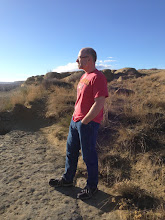To the left is a wide, slow river moving ponderously but faithfully down a grade of less than ten inches every mile. It is mostly muddy and slow, but it can be treacherous at times. Let it be the movement of philosophy and ideas down through the years. It is full of thoughts and discoveries, and it is calling people to a certain standard of living; a life of joy, or courage, or sacrifice. At times it contains such a high and lofty ideal for us that we could never hope to reach it. What’s more, we often can’t even see the idea, for the water is churned up and full of sediment. For centuries men and women have been able to float about on its surface, but going deeper is too troublesome. The water is not clear enough.
To the right is a roaring mountain stream. It is as wide as the other, yet deeper. It may momentarily collect in a pool, but for most of its journey it is racing through rapids, squeezed between daunting cliffs and pouring over the edges of waterfalls. It is vibrant and dangerous and moving unstoppably. This is history. It is the motion and movement of real people in real situations, making decisions and catastrophic choices which propel the whole monster forward. The undertow is deadly. Nothing can stop its flow. Everything is caught up in it as it tumbles along. It is not changeable – rather, it changes the landscape as it moves along.
One tells us the way things should be – the other tells us the way things really are. Somewhere up ahead, the two will meet.
Now consider that some moral philosopher may speak for hours on end to try to get people to behave in a more humane manner. Like the slow moving river, he can inspire, but not enough. He can whip people into a frenzy, but not forever. Most philosophies are impenetrable to the masses, and uninteresting as well. You may swim around in them for hours and never find one compelling reason to do anything noble. It is a cerebral exercise, a tedious mystery.
History however leaves us with the opposite: not what should be, or what could be, but rather what really is, and how short it falls. How few heroes of Right and Wrong have lived up to their potential? How many monsters have had a greater impact on their world and generation than a thousand martyrs? How frustrating it is to look at the merely human endeavors there and find in them some hope for mankind. We cannot force history into a high standard for our lives, for it is simply too broken, too human.
These two streams meet at a junction which has been an expression of humanity’s creativity for thousands of years. For where our ideals meet our experience, we tell stories.
Now these stories, as has been noted, come from two streams, and there can be two results. The first is that the water from each creates a reservoir, a deep, clear lake from which we can drink, a source of sustenance. This happens when we have worthy ideals, when we recognize the faulty ones, when we understand human nature rightly, and when we apply the two together to create worlds where reality is made tangible for people.
But the other possibility is not a store of nourishing water, but a swamp; a flat, sulfurous bog of stagnant water filled with bacteria and breeding insects. This is what happens when we create literature which embraces the basest ideals (or none at all) or when people go looking only to what is and try to extract some meaning or purpose out of it, rather than imposing on the world an ennobling element from the stream of conscience and morality.
What we see in our world is that, too often, the confluence of these two streams results in a malarial bog of hopeless tripe. Either the level of artistic achievement is high and the ideals are low, or else the ideals are high and the artistry is low. We need deep waters, and clear. We require so much more than we have been given. We’ve grown accustomed to settling, so much so that we can barely recognize any longer the potential which exists for real creativity.
It may be that a renewal of true art among believers will accompany, or precede, an increase in the quality of our religion, for the highest ideas in creation deserve the very best creations we can produce.
Monday, September 8, 2008
Subscribe to:
Comments (Atom)
